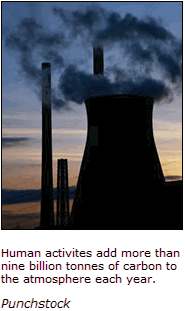|
|
|
|
|
|
|
News & Views item - November 2006 |
![]() Beijing
Earth Science Conference Told Carbon
Emissions Now Rise By 3.2% p/a -- Up From 0.8% p/a 1990-99 Level.
(November 14, 2006)
Beijing
Earth Science Conference Told Carbon
Emissions Now Rise By 3.2% p/a -- Up From 0.8% p/a 1990-99 Level.
(November 14, 2006)
Australia's Prime Minister, John
Howard, looks increasingly like a legacy from the 19th century as he
continues to straight-jacket development of alternative carbon-free and
renewable energy sources, refuses to have Australia become a leader in the use and development of clean
energy technology, but rather employs obfuscation to champion the use of fossil
fuels to the virtual exclusion of all else.
refuses to have Australia become a leader in the use and development of clean
energy technology, but rather employs obfuscation to champion the use of fossil
fuels to the virtual exclusion of all else.
Nuclear power plants in Australia?
As has been perceived by members of the private sector, it is a prime ministerial ploy. It won't happen; it's an attempt to keep the alternative energy advocates at bay.
And we now have Mr Howard's announcement of a joint business-government task group to consider how emissions trading might work in Australia and globally. Following the well used practice of "when you want to be seen to be doing something when you really don't want to do anything... set up a committee (task group)?
And all the while Mr Howard continues to belittle those advocates for action, such as Sir Nicholas Stern, by exercising hyperbole, suggesting that they proclaim that the catastrophic effects of climate change will arrive the day after tomorrow if not sooner, but he, with lance and sword to the fore, on his white charger, will champion Australian wellbeing against all evildoers.
But as Nature's Nicola Jones reports, "Global carbon emissions are now growing by 3.2% a year, according to results presented at an Earth science conference in Beijing on 9 November. That's four times higher than the average annual growth of 0.8% from 1990-99.
"We are not on any of the stabilization paths," says Michael Raupach, a carbon-cycle scientist with the Commonwealth Scientific and Industrial Research Organization (CSIRO) in Canberra, who presented the Global Carbon Project results at the conference. He continued, "What's really striking is the rate of growth in places like China."
According to Chinese figures, China currently contributes some 16% to global emissions, but accounts for 40% of the growth in world emissions.
Its officialdom claims China plans to reduce the amount of its "energy intensity", defined as the emissions per person per unit of GDP, by 20% by 2010, although it has no official emissions targets.
[perhaps we oughtn't to lose sight of the fact that Australian's are the biggest carbon polluters per capita on the planet - a point Mr Howard steps lightly over]
Sea-level rise is also at the upper end of
Intergovernmental Panel on Climate Change (IPCC) projections, John Church, who
works at CSIRO Marine and Atmospheric Research in Hobart, points out analyses
published in 2006 have shown that sea level is currently rising at 1.5-2 mm per
year, which is in the upper half of the IPCC value of 1-2 mm per year, and the
rate of the rise is accelerating.
On the basis of these data current
predictions are an 88 cm (35 inch) rise in sea level by 2100. "We have to start
acting soon — it's urgent," says Church. Raupach's results, he says, are "really
striking".
The data for global emissions come mainly from the Carbon Dioxide Information Analysis Center, based at the Oak Ridge National Laboratory in Tennessee.
In Raupach's opinion scientists are now in a position "where we can 'nowcast' the carbon cycle; we're about to publish this for 2005 and we can continue to do that live."
But perhaps Mr Howard subscribes to a verse of Bob Marley and being a man of the people:
|
i give
you my phone number, |